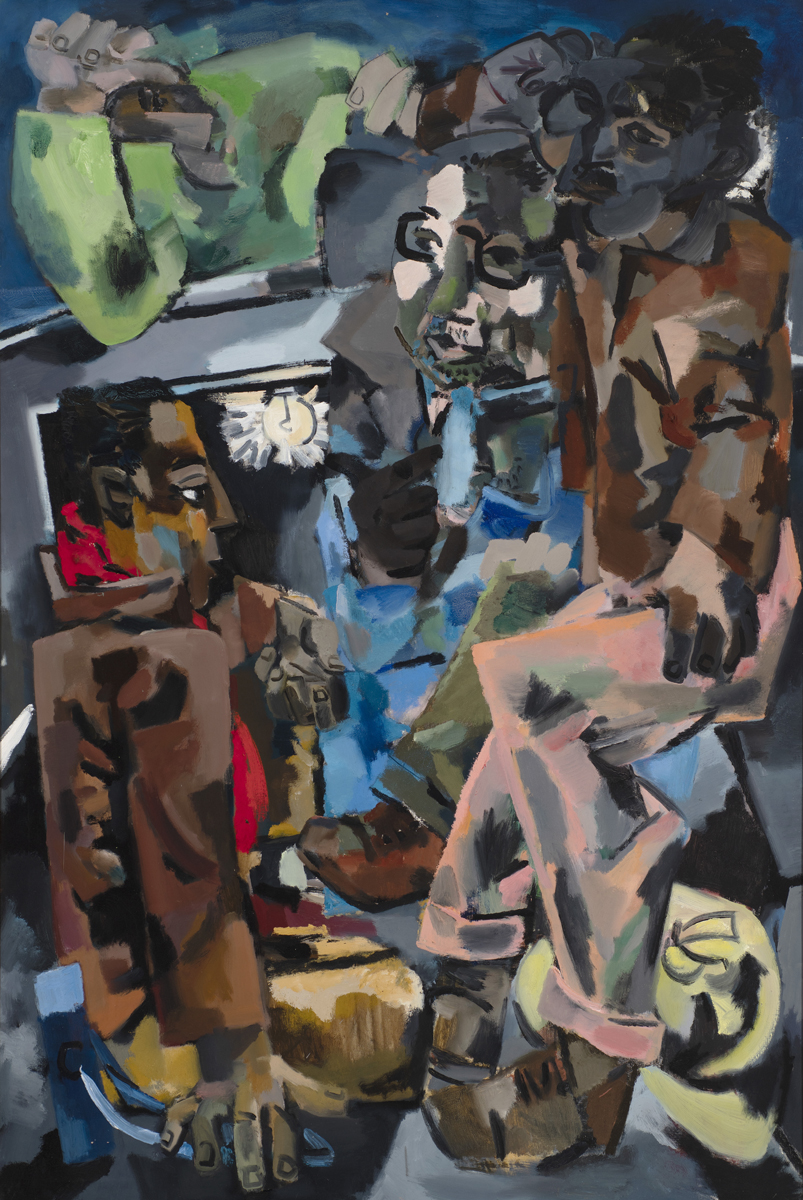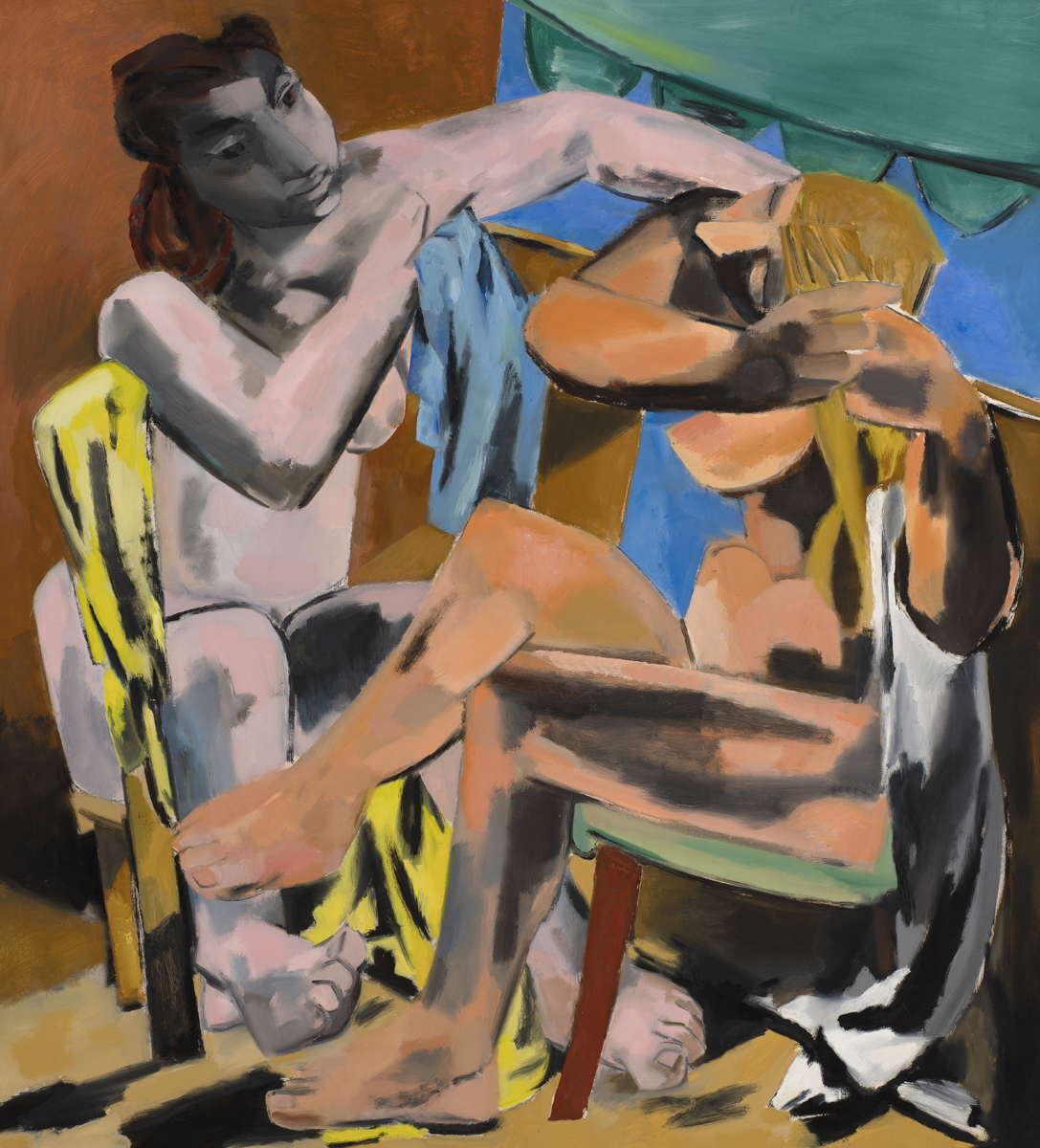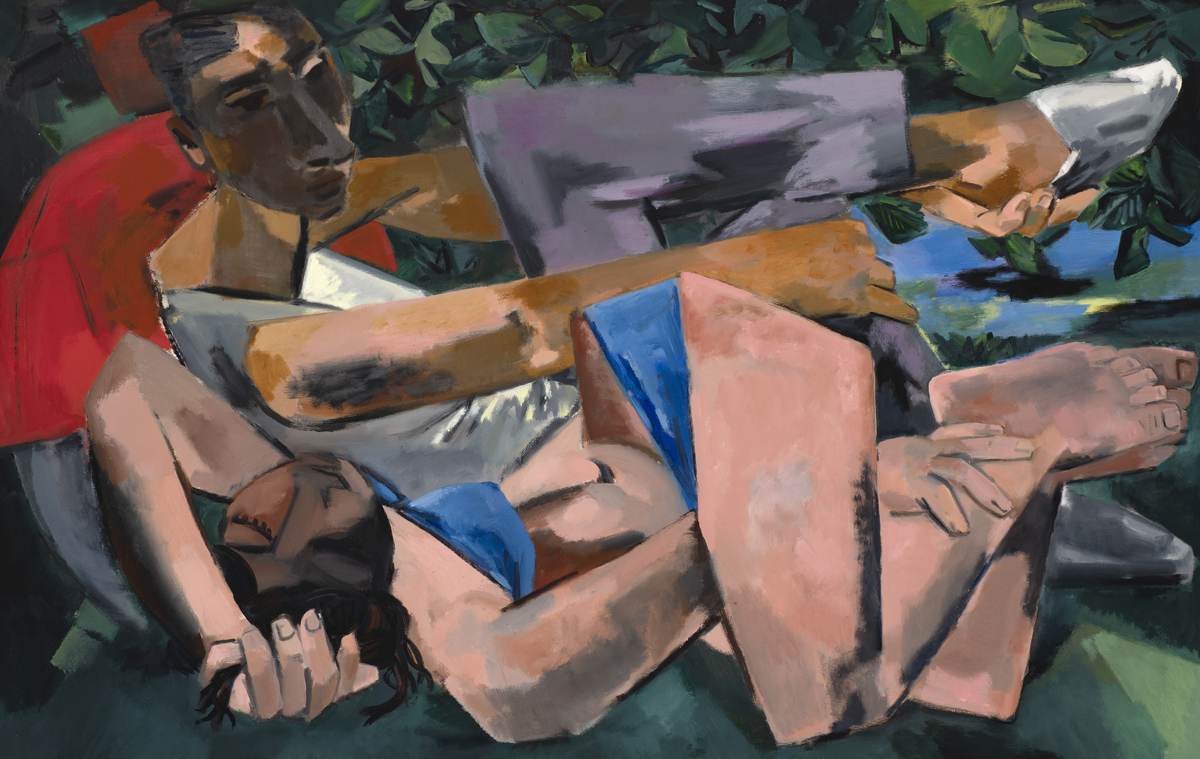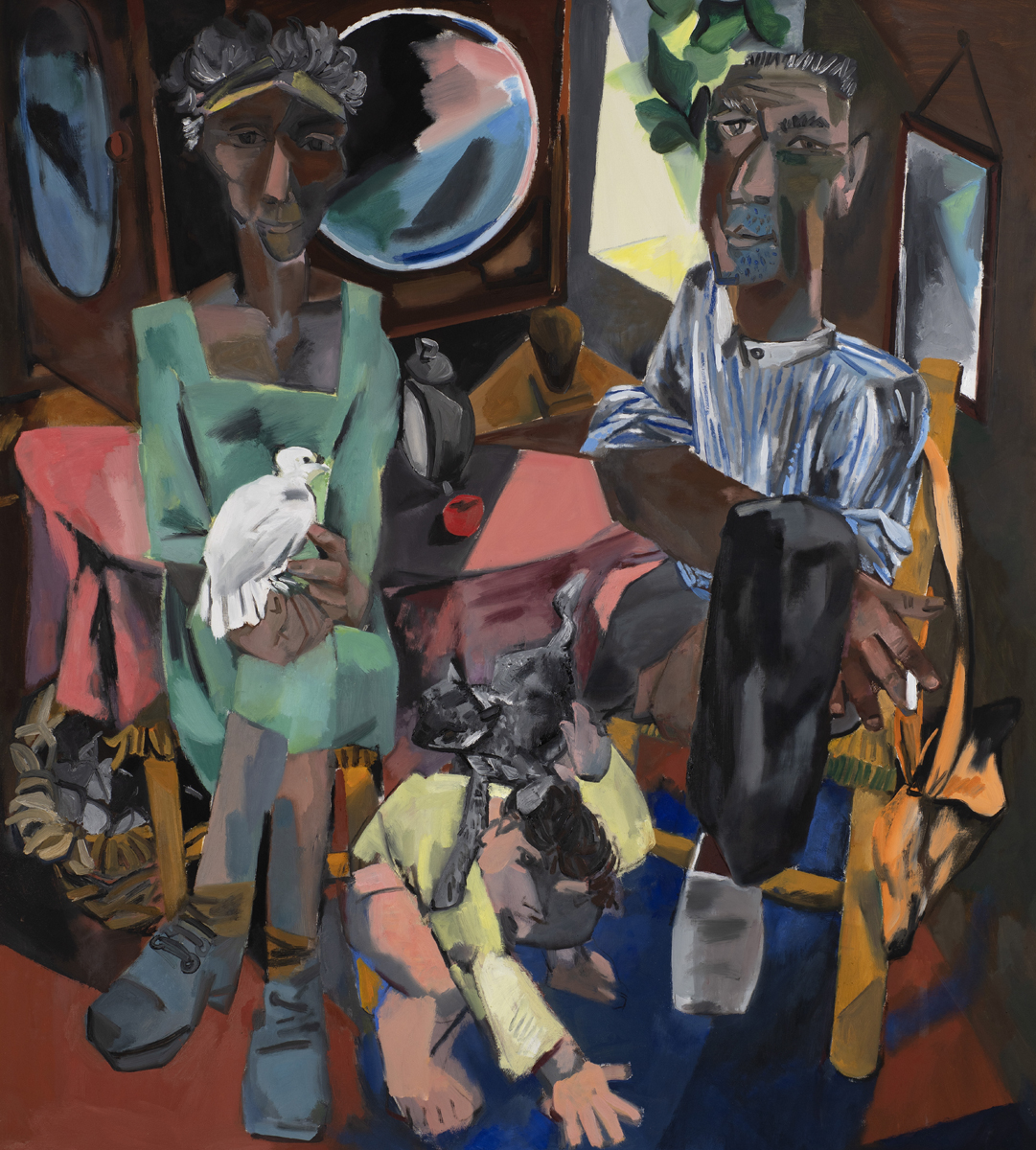One striking feature of the paintings of Peter de Francia (1921–2012) is that they often evoke an urge to converse. In Algerian Storyteller (1964–5), one of a number of works inspired by the artist’s travels around the Maghreb, a Homeric orator is surrounded by his fellow emigrants, their bodies linked together, creating a concentric circle that radiates from the small yellow lamp in the centre. A year after its completion, the painting was included in ‘Situation 66’, an exhibition organised by a small group of artists in Augsburg who tried to break the Cold War barrier and show art from both Eastern and Western European countries – Grundig, Picasso and Moore were also among the participants. Looking at de Francia’s painting today, the viewer is reminded of cold and hot wars of our own time, with their same mixture of loss, exodus and desperation.

De Francia is best known for charcoal drawings often conceived as series, ranging from his satirical Disparates to the metaphorical Fables, that share an affinity with the graphic works of Goya, Daumier and Grosz, as well as socially committed paintings such as The Execution of Beloyannis (1953), The Bombing of Sakiet (1959) and African Prison (1960) that bear comparison with Guttuso, Picasso and Beckmann. Yet in spite of his accomplishments, his work has remained largely unfamiliar to the public. Though one of the greatest humanist painters of the period, de Francia is completely absent from the Barbican’s current survey of post-war British art. This is in stark contrast to Francis Bacon, whose works are also being lavishly shown at the Royal Academy.
Two commercial galleries however have made new efforts to exhibit de Francia’s work. Three months ago, the James Hyman Gallery – whose owner is an art historian and a long-time dealer of de Francia’s work – presented his Disparates drawings alongside five paintings, including three from The Violation of Innocence series completed in the late 1980s. This month, the Fine Art Society has an exhibition across their two locations focusing on de Francia’s paintings, with easel-sized pieces mainly in London and large works in Edinburgh. With one or two exceptions, these are introduced in the accompanying catalogue as ‘pastoral’ paintings that show ‘a different artist’ – the artist of ‘withdrawal’, who purchased a house in the French village of Lacoste in 1957 – apparently in contrast to the ‘engaged’ artist who penned an essay the very same year on ‘art, criticism and commitment’ for the first issue of Universities and Left Review. But are these paintings detached from the more explicitly committed works by de Francia – an artist who was convinced that ‘art is a supreme manifestation of life, inseparably bound up with social and philosophical beliefs’?
De Francia was born in Beaulieu in 1921 to an Italian father and an English mother. Raised in Paris, he took up drawing lessons at the age of thirteen and began to sketch at the Louvre, developing his visual memory and ability to capture movement. A school trip to Fort Douaumont in Verdun was an early confrontation with the cruelty of war: there was more metal around than earth; the bones of soldiers were piled up in the ossuary. He left France for Belgium in 1938 to study at the Académie Royale des Beaux-Arts in Brussels, but had to flee the country two years later on a bicycle when Germany invaded Belgium. The chaotic scenes of mass evacuation – thousands of people intermingled with livestock heading southwest, the French and British Allies advancing in the opposite direction, German machine guns overhead – resembled Brughel’s Dulle Gret to the young artist, and brought his political consciousness into sharp focus.
Moving to England, de Francia joined the British Army and served in the counter-intelligence unit, tasked with interpreting aerial photographs. Afterwards he received a grant to study at the Slade in London, which he found uninspiring. It was the time he spent in Italy after he left the Slade that proved to be the most formative period for his art. There, he befriended Renato Guttuso – a former partisan and a prominent figure in the PCI who was renowned for his socially committed expressionism. De Francia worked in his studio, revering the Italian painter for his political engagement in life and art. After Italy, de Francia worked briefly in New York, where he met Max Beckmann and George Grosz. Beckmann’s triptychs and Grosz’s depiction of human figures as types rather than specific characters were discernible influences on de Francia’s work. Returning to Britain in the early 1950s, he worked for a short while producing fine art programmes for the BBC, before starting to teach at various art colleges in London, which eventually sustained his painting.
The earliest work in the Fine Art Society exhibition dates from 1951. It is a portrait of de Francia’s girlfriend of the time resting in bed, her arm around the head, her eyes looking slightly downward, absorbed in thought. A blue jumper and grey trousers are painted with expressive brushstrokes, applied in parallel to emphasize the sculptural form of the body underneath. The dominance of the red fabric on the bed resembles Guttuso’s palette. Other portraits from the time on show include depictions of working-class people situated in their daily life: a sun-tanned worker in blue overalls bending over the machinery in a lavender distillery; a Tunisian shoeshine boy resting on some cardboard scattered on the ground, his brush – or a bag in another version – placed near him; a bird seller sitting on a bench in a corner reminiscent of the travellers in Daumier’s The Third-Class Carriage.

These portraits were completed in the same period that de Francia painted a series of portraits of left-wing intellectuals including Eric Hobsbawm and Anna Bostock. Though not included in this exhibition, these are important works in his oeuvre, recording a moment of lively social and intellectual activity which shaped the trajectory of de Francia’s painting. De Francia was close to John Berger, with whom he shared a house, and became one model for the character Janos Lavin in Berger’s first novel A Painter of Our Time (1958). When Berger set up the Geneva Club in 1955, de Francia became an active member. Appropriating the name of the Geneva Conference that marked a brief thaw in the Cold War era, the Geneva Club held meetings in Soho, aiming to ‘stimulate a continental-style social debate’. At these meetings, de Francia met future ULR editors, who invited him to contribute to the journal and advise on visual arts.
A sense of camaraderie entered de Francia’s painting in subtle ways, gradually transforming the theatrical mise-en-scène that characterised his early epic paintings. This is particularly evident in the double- and multi-figure compositions that he produced from the sixties onwards. In the painting of an Algerian couple lighting a lamp, Lighting Lamps (1970), a feeling of mutual reliance is invoked by a repeated pattern of semi-circles: half of the plate that the light falls on, the seats arranged around the lamp, the woman’s folding arms rested on the back of the chair that has been turned around. The semi-circle structure reappears in a couple of paintings depicting women washing their bodies. In one of them, Women Washing (1976), the woman drying her hair turns her face towards the woman wiping her armpit, the latter looks at her companion with slightly opened mouth. Even in the painting of a reclining woman under a window, Reclining Nude with Radio (1970s), the radio that she is tuning conveys a sense of communication.

Such sensuous depictions of human bodies are partially achieved through a brightened palette. Browns and blacks become more chromatic while greens and pinks are more saturated. Turquoise green illuminates the space behind a woman washing her feet; a towel in bright lemon yellow links a pair chatting; orange bleeds into brown and pinks turn greys into silvery blues and olive greens. In the Fine Art Society’s London gallery, which has a domestic atmosphere, the exhibits include a cluster of seven glass jars on a small bookshelf. The jars are filled with pigments of vibrant colours – primaries, orange, pink and two shades of green, and next to them lays a worn-out inch-wide brush. De Francia made paints from these pigments instead of using paints from tubes. He applied little medium in painting, which explains why the colours have retained a matt, mural-like quality without oil sheens. He primed his medium-grained linen canvas with a white ground, which helped to enhance luminosity of the colours.
Looking at these paintings of human bodies in intimate space, viewers may well ask: had de Francia retreated from commitment in his art? To answer, it is useful to consider the three methods of committed art that he proposed in his 1957 essay ‘Commitment in Art Criticism’:
Three methods exist, in visual art, of attacking chaos. The establishing of an unblemished, recurrent classicism, standing outside the direct influence of time but using certain basic contemporary symbols: the attempt, let us say, to create a pictorial or architectural morality. This is the kind of task that Léger set himself, by intelligent choice rather than by instinct. Second, an art of violent satire, usually of momentary circumstance, such as that used by George Grosz, or of violent exaggeration of collective or individual grotesqueness, such as that of the late paintings of Orozco. In both these cases the moral aspects of the work are dependent on the use of straightforward or inverted traditional moralities. Finally, there is an art of a deliberately social character, using a pictorial language which is extremely simple, and relying – like Guttuso’s – entirely on dynamic content. The attempt here is to project, by sheer power of imagery, to establish a language of communication which lies outside a formula of aesthetics. It is understood, in such art, that morality is treated as a force created by the content of the work.
This triad of approaches may best sum up de Francia’s own artistic strategies. His early history paintings would belong to Guttuso’s line of attack, which relies on the content of the work to express a moral position. His allegorical works may be categorized as following Grosz’s method, which pushes the power of satire to its limits through typification of human nature and exaggeration of its grotesquery. This includes many of his drawings and some paintings such as Ship of Fools (1972). The paintings of human bodies, meanwhile, especially those in monumental scales, come closest to Léger’s approach, an unadorned classicism aimed at creating an architectural morality.

A recurrent motif in many of the paintings from the sixties and seventies is the bicycle, painted in eye-catching primary colours. In Reclining Figures (1974), the pensive man leaning against a red bicycle reminds us of the artist’s own experience of pedalling away from the German invasion. In other paintings, it anchors conversations in the way that benches in a garden or chairs under a porch do. In a few paintings featuring a courting couple, the bicycles extend the human bodies, endorsing them with a kind of monumentality. Village Couple II (c. 1982) captures the moment when a black cat emerges from underneath a table, disrupting the quiet company of a grey-haired couple. It jumps onto the head of the child playing on the floor, who raises one arm to catch the cat, arching his back just like the cat does. The lines are all stirred up to tilt, skew, or bend into semi-circles. There is no need for a didactic statement, no need to mention the Falklands, Lebanon, Afghanistan…The dove in the woman’s hands is enough to express an eternal desire for peace.

De Francia was always concerned with the relationship between art and society, believing that social and political changes were needed to help solve problems in art. He argued for legislation to allocate a budget for public art and was outspoken about the relation between art and politics at conferences and in tutorials. In 1980 the newly appointed rector at the Royal College of Art – a designer of coinage who wished to divert resources away from fine art towards more narrowly productive fields – attempted to force de Francia to resign from his position as Professor of Painting, threatening legal action, on account of his political subversiveness. De Francia fought back and remained in position after every tutor and student rebelled by signing a protest letter in support.

The latest painting in the exhibition, titled Philosophers (1999), depicts two standing figures engaged in debate in a space half enclosed by shrubs and low walls. The young man on the left, dressed in a blue shirt, holds an open book in one hand and a fish in the other, staring at his interlocutor with a challenging look. With one foot ahead of the other, he resembles the traveller in Courbet’s La rencontre. The old man on the right, with vividly painted yellow shirt and pink scarf, appears to be silent, but his gestures – one hand pointing at the fish and the other reaching to an overturned ancient bust next to his feet – contest the young man. If the encounter can be read as a debate about the validity of painting in our time, then de Francia’s own words from his inaugural lecture at the Royal College of Art in 1973 seem to have suggested a possible answer: ‘Painting has one thing in common with written and spoken language and this lies in the fact that when it attains the power of projecting a force sufficiently strong to create history, it becomes essentially and intrinsically political.’
In a series of interviews conducted at the turn of the new century, de Francia made two sharp observations about the British culture. One is that there is a lack of sensuality but an obsession with sexuality; the other is that any artist who is interested in politics is labelled as ‘political artist’ in a derogatory way. His own paintings have testified that the sensual and the political are not mutually exclusive; or rather, they necessitate one another.
Read on: John Berger, ‘The Moment of Cubism’, NLR I/42.